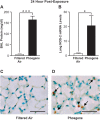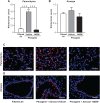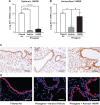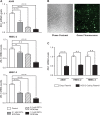NOS-2 Inhibition in Phosgene-Induced Acute Lung Injury
- PMID: 25870319
- PMCID: PMC4476462
- DOI: 10.1093/toxsci/kfv072
NOS-2 Inhibition in Phosgene-Induced Acute Lung Injury
Abstract
Phosgene exposure via an industrial or warfare release produces severe acute lung injury (ALI) with high mortality, characterized by massive pulmonary edema, disruption of epithelial tight junctions, surfactant dysfunction, and oxidative stress. There are no targeted treatments for phosgene-induced ALI. Previous studies demonstrated that nitric oxide synthase 2 (NOS-2) is upregulated in the lungs after phosgene exposure; however, the role of NOS-2 in the pathogenesis of phosgene-induced ALI remains unknown. We previously demonstrated that NOS-2 expression in lung epithelium exacerbates inhaled endotoxin-induced ALI in mice, mediated partially through downregulation of surfactant protein B (SP-B) expression. Therefore, we hypothesized that a selective NOS-2 inhibitor delivered to the lung epithelium by inhalation would mitigate phosgene-induced ALI. Inhaled phosgene produced increases in bronchoalveolar lavage fluid protein, histologic lung injury, and lung NOS-2 expression at 24 h. Administration of the selective NOS-2 inhibitor 1400 W via inhalation, but not via systemic delivery, significantly attenuated phosgene-induced ALI and preserved epithelial barrier integrity. Furthermore, aerosolized 1400 W augmented expression of SP-B and prevented downregulation of tight junction protein zonula occludens 1 (ZO-1), both critical for maintenance of normal lung physiology and barrier integrity. We also demonstrate for the first time that NOS-2-derived nitric oxide downregulates the ZO-1 expression at the transcriptional level in human lung epithelial cells, providing a novel target for ameliorating vascular leak in ALI. Our data demonstrate that lung NOS-2 plays a critical role in the development of phosgene-induced ALI and suggest that aerosolized NOS-2 inhibitors offer a novel therapeutic strategy for its treatment.
Keywords: acute lung injury; lung epithelium; nitric oxide synthase 2; phosgene; surfactant protein B; tight junction protein 1.
© The Author 2015. Published by Oxford University Press on behalf of the Society of Toxicology. All rights reserved. For Permissions, please e-mail: journals.permissions@oup.com.
Figures






Similar articles
-
Corticosteroids found ineffective for phosgene-induced acute lung injury in rats.Toxicol Lett. 2014 Aug 17;229(1):85-92. doi: 10.1016/j.toxlet.2014.06.011. Epub 2014 Jun 6. Toxicol Lett. 2014. PMID: 24910984
-
Single high-dose dexamethasone and sodium salicylate failed to attenuate phosgene-induced acute lung injury in rats.Toxicology. 2014 Jan 6;315:17-23. doi: 10.1016/j.tox.2013.11.005. Epub 2013 Nov 23. Toxicology. 2014. PMID: 24280380
-
Bone marrow-derived mesenchymal stem cells attenuate phosgene-induced acute lung injury in rats.Inhal Toxicol. 2015;27(5):254-61. doi: 10.3109/08958378.2015.1037029. Epub 2015 May 13. Inhal Toxicol. 2015. PMID: 25970824
-
Phosgene inhalation toxicity: Update on mechanisms and mechanism-based treatment strategies.Toxicology. 2021 Feb 28;450:152682. doi: 10.1016/j.tox.2021.152682. Epub 2021 Jan 20. Toxicology. 2021. PMID: 33484734 Review.
-
Therapeutic treatments of phosgene-induced lung injury.Inhal Toxicol. 2004 Jul;16(8):565-80. doi: 10.1080/08958370490442584. Inhal Toxicol. 2004. PMID: 15204747 Review.
Cited by
-
An Official American Thoracic Society Workshop Report: Chemical Inhalational Disasters. Biology of Lung Injury, Development of Novel Therapeutics, and Medical Preparedness.Ann Am Thorac Soc. 2017 Jun;14(6):1060-1072. doi: 10.1513/AnnalsATS.201704-297WS. Ann Am Thorac Soc. 2017. PMID: 28418689 Free PMC article.
-
Review of Inhalation Health Risks Involving Chloromethylisothiazolinone (CMIT) and Methylisothiazolinone (MIT) Used as Disinfectants in Household Humidifiers.J Korean Med Sci. 2022 Apr 4;37(13):e101. doi: 10.3346/jkms.2022.37.e101. J Korean Med Sci. 2022. PMID: 35380026 Free PMC article. Review.
-
Phosgene-induced acute lung injury (ALI): differences from chlorine-induced ALI and attempts to translate toxicology to clinical medicine.Clin Transl Med. 2017 Dec;6(1):19. doi: 10.1186/s40169-017-0149-2. Epub 2017 Jun 2. Clin Transl Med. 2017. PMID: 28577109 Free PMC article. Review.
-
Tight Junctions, the Epithelial Barrier, and Toll-like Receptor-4 During Lung Injury.Inflammation. 2022 Dec;45(6):2142-2162. doi: 10.1007/s10753-022-01708-y. Epub 2022 Jul 2. Inflammation. 2022. PMID: 35779195 Free PMC article. Review.
-
Countermeasures against Pulmonary Threat Agents.J Pharmacol Exp Ther. 2024 Jan 17;388(2):560-567. doi: 10.1124/jpet.123.001822. J Pharmacol Exp Ther. 2024. PMID: 37863486 Free PMC article. Review.
References
-
- Alexander D. J., Collins C. J., Coombs D. W., Gilkison I. S., Hardy C. J., Healey G., Karantabias G., Johnson N., Karlsson A., Kilgour J. D., McDonald P. (2008). Association of Inhalation Toxicologists (AIT) working party recommendation for standard delivered dose calculation and expression in non-clinical aerosol inhalation toxicology studies with pharmaceuticals. Inhal. Toxicol. 20, 1179–1189. - PubMed
-
- Balakumar P., Kathuria S., Taneja G., Kalra S., Mahadevan N. (2012). Is targeting eNOS a key mechanistic insight of cardiovascular defensive potentials of statins? J. Mol. Cell. Cardiol. 52, 83–92. - PubMed
-
- Baron R. M., Carvajal I. M., Fredenburgh L. E., Liu X., Porrata Y., Cullivan M. L., Haley K. J., Sonna L. A., De Sanctis G. T., Ingenito E. P., Perrella M. A. (2004a). Nitric oxide synthase 2 down-regulates surfactant protein B expression and enhances endotoxin-induced lung injury in mice. FASEB J. 18(11), 1276-1278. - PubMed
-
- Baron R. M., Carvajal I. M., Liu X., Okabe R. O., Fredenburgh L. E., Macias A. A., Chen Y. H., Ejima K., Layne M. D., Perrella M. A. (2004b). Reduction of nitric oxide synthase 2 expression by distamycin A improves survival from endotoxemia. J. Immunol. 173(6), 4147-4153. - PubMed
-
- Brown R. F., Jugg B. J., Harban F. M., Ashley Z., Kenward C. E., Platt J., Hill A., Rice P., Watkins P. E. (2002). Pathophysiological responses following phosgene exposure in the anaesthetized pig. J. Appl. Toxicol. 22, 263–269. - PubMed
Publication types
MeSH terms
Substances
Grants and funding
LinkOut - more resources
Full Text Sources
Other Literature Sources
Medical
Research Materials

